We occasionally link to goods offered by vendors to help the reader find relevant products. Some of these may be affiliate based, meaning we earn small commissions (at no additional cost to you) if items are purchased. Here is more about what we do.
If you’re not using a boning knife or gokujo to dress cooked and uncooked meats, you might be missing out on some of the tastiest morsels.
Meats get a lot of their flavor from the fat, bone, and blood that contacts the muscle, and if you’re just cutting the meat away with, say, a chef’s knife, you’re leaving a lot of flavor on the bone.
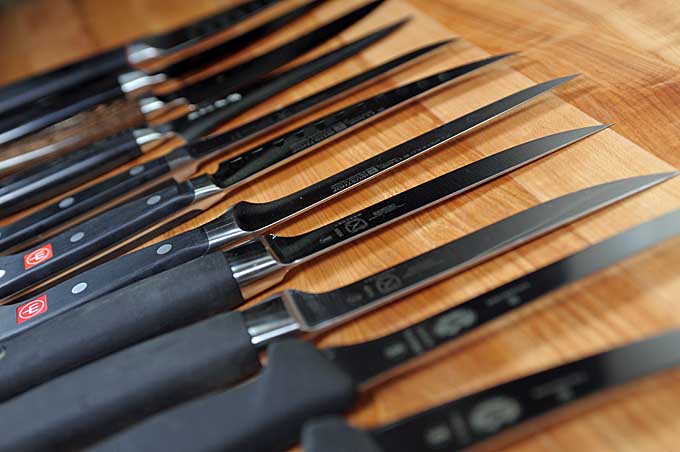
Plus, if you’re looking for ways to stretch your food budget, investing in a good boning knife can lead to some nice savings.
Learning how to break down a whole chicken, trim a brisket, or fillet a salmon are smart and economical options compared with buying premium cuts with their premium prices – but you need the right tool for the job.
Our Favorite Boning Knives
- Wusthof Classic
- Victorinox Fibrox Pro
- Shun Classic Gokujo
- Enso HD Hammered Damascus
- Shun Premier Gokujo
- Dalstrong Phantom
- Mercer Genesis
- Henckels Classic Semiflex
- Dexter-Russell Sani-Safe
In this guide, we’re looking at the different components of a boning knife, like flexible and rigid blades, shape and size considerations, and the basic differences between boning and fillet knives and gokujos (Japanese-style boning knives) so you can choose one that will best serve your needs. Then we wrap up with a variety of boning knife reviews for your consideration.
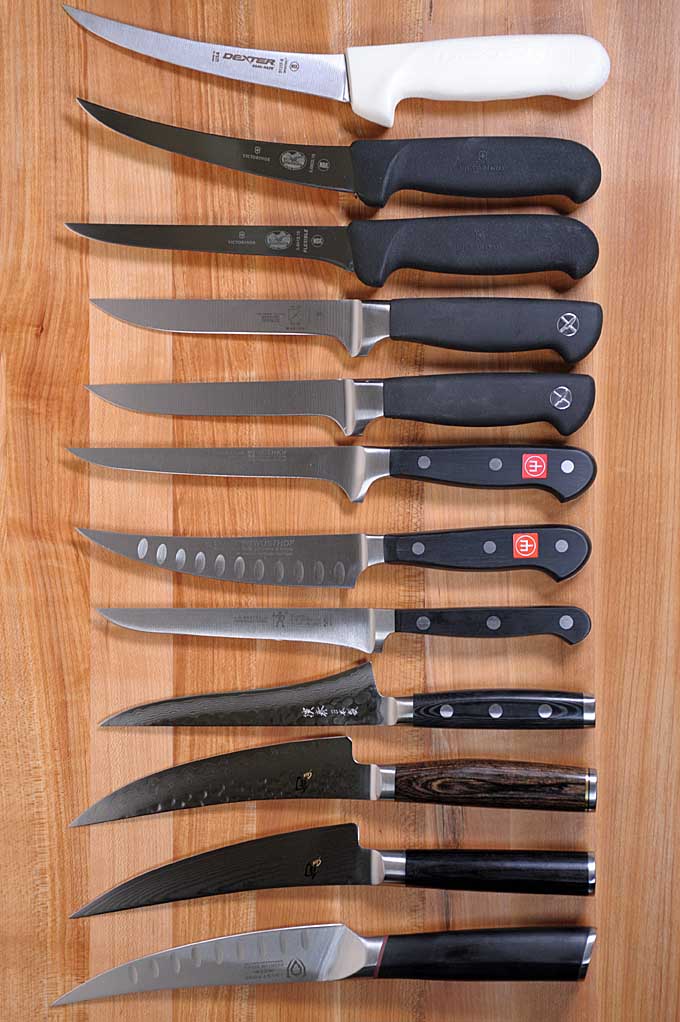
Bottom Line Up Front: Our Top Pick for Most People
We found the Wusthof Classic Flexible Boning Knife to be best suited for most home and professional chefs alike.
Why? The shape is a classic boning profile, and the flexibility of the blade allows the metal to easily follow the contours of the bone or the fillet of a fish.
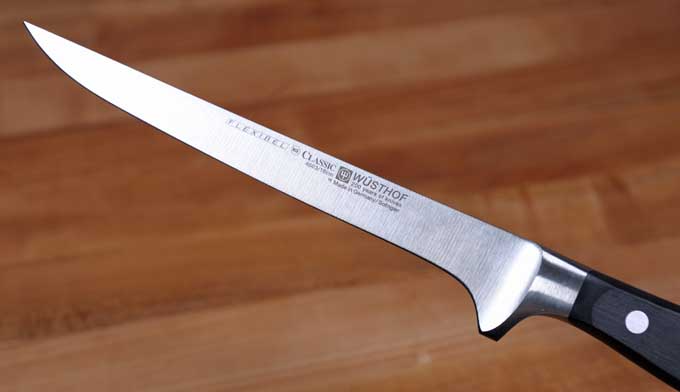
Wusthof Classic 6-Inch Flexible Boning Knife, available from Amazon
The metal stays sharp for a fairly long time (although nothing like Japanese gokujo will) and can be easily “tuned up” with a steel. The metal is still soft enough that the blade can be sharpened with any conventional sharpening system or even a electric sharpener (not our favorite way but the option is there).
It doesn’t require an investment in Japanese water stones or exotic jig-based systems.
See it on Amazon or read more about this model below.
Although we’ve determined that the Wusthof is the best for most people, there are some exceptions to this blanket statement. We love the Shun Classic, Shun Premier, and the Enso HD Hammered Damascus much more than the Wusthof.
These models, made up of more advanced and harder metal alloys, retain their edge through a massive amount of protein, and we also appreciate their feel, fit and finish, and aesthetics. When you hold these blades, you understand that they were assembled by craftsmen of the highest caliber.

Enso HD Hammered Damascus 6-Inch Boning Knife, available through Amazon
But the brittleness of the blade and the difficulty in sharpening metal that is as hard as those found in these brands (and most Japanese-produced knives) limits us to recommending these products as the best choice for everybody.
However, they may in actuality be the best for some folks, depending on your knife skills and familiarity with these types of tools. And the Shuns do include a free lifetime sharpening service, so that does open the doors to some who otherwise would be better off with a different blade.
Read all of our boning knife reviews now.
Why You Should Trust Us
We spent well over a $1,000 and over 40 hours pre-screening our list of recommendations, buying the knives, and then testing them on various chunks of protein including beef, poultry, venison, pork, and lamb.
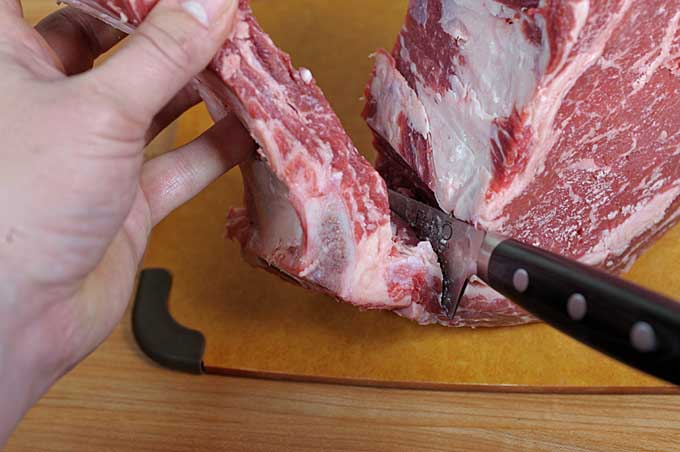
We’ve lived with these knives for over three months and have used them daily to get a feel for characteristics of each blade.
Boning, Fillet, and Gokujo Knives: What Are the Differences?
At first glance, boning and fillet knives look similar, and the uninitiated might think they’re pretty much interchangeable.
While the differences might seem subtle, their application can be significantly different – which means their ease of use, and the results you achieve, will be different as well.
A boning knife is most commonly used to remove bones from meat, game, and poultry. A fillet knife has greater blade flexibility, and is designed to more easily move with contours to remove bones and skin from smaller pieces, like chicken and fish.
With Western knives, these functions are usually kept separate – but there are some models that overlap, with an all-purpose knife used for both purposes.
With Japanese kitchen knives, there are several models used specifically for filleting and portioning fish and sashimi, such as the deba or yanagi.
The gokujo (which means “all-in-one”) is more multipurpose in nature and can be used for both boning and filleting.
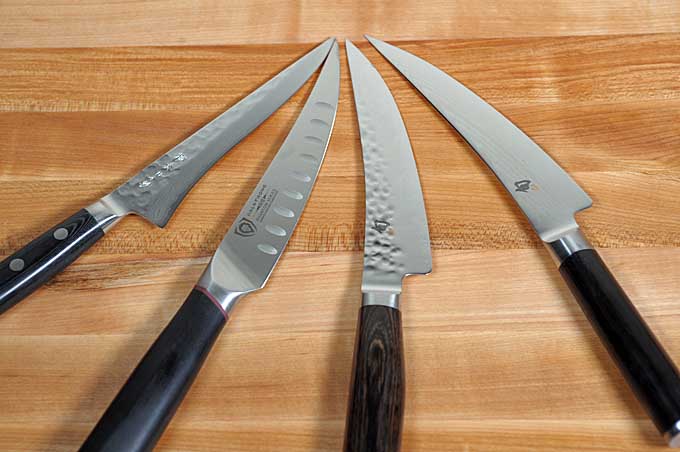
However, most gokujos have a fairly stiff blade. This makes them suitable for filleting large fish like salmon or tuna, but unless you have a masterful technique, their rigid nature makes working on smaller fish somewhat challenging.
They make excellent trimming tools and are great for detailed work.
Fillet knives have a similar appearance, although they might not have the same sharp, pointy tip, and the blade will usually have considerably more flex.
This is helpful to work around the small, soft bones of fish and chicken, and to remove skin.
And because of the delicate nature of fish flesh and their small skeletal structure, we recommend using a true fillet knife for the task. It makes filleting a lot easier, and for the beginner, results will be much more appealing – and encouraging.
Flexible or Semi-Stiff Blades
When used properly, a boning knife will leave very little waste, as it cleanly removes meat from connective tissue and bone without cutting through or damaging the muscle.
It features a long, narrow blade and thin cross section with a very sharp tip for piercing. Pliability of the blade will vary depending on what you plan to bone – semi-stiff and flexible being the two most common properties.
A semi-stiff blade is used for larger pieces, such as beef, pork, lamb, and game, or any time when a bit more oomph is needed to cut through thicker pieces of meat.
You don’t want to use a flexible knife on these big tasks because too much flex creates a lateral motion. And when applying the necessary pressure to remove ribs or a back bone, they can easily bend and cause injury.
A flexible version is better suited for thinner items, or proteins with smaller bones that require a bit more dexterity. A flexible blade is the way to go when you want the blade to bend along contour lines, such as with poultry or fish, and when removing skin or trimming excess fat and soft tissue like “silver” skin.
A Finger Guard for Safety
Another common feature on all boning knives is a finger guard, an important consideration when handling slippery skin and fat.
On some, the bolster will drop down along the blade heel to prevent a finger slipping along the cutting edge. Others will have a finger guard built into the handle, making all of the blade usable.
This feature is a matter of personal preference – choose whatever style you feel gives the best in safety and confidence.
Shape and Size
Traditional boning knives have a blade length of 5 to 6 inches, although some will reach as long as 9 inches. And the cutting edge will be relatively straight from the heel, with an upward curve to the sharp tip to travel around rounded bones.
However, arched blades have become quite popular. With these models, the entire blade rises upwards from the handle like a scimitar. This shape is particularly adept at skinning and trimming, as a single pass of the blade from heel to tip will often cleanly remove skin and slice through layers or fat without any back and forth motion.
Editor’s Note
Although you will want to also have a more traditional straight blade model in your arsenal, I’m finding that the arched blade models such as the Wusthof Classic 6-Inch Curved Boning Knife, the Shun Premier Gokujo, and the Shun Classic Gokujo make for excellent replacements for utility or large petty knives.
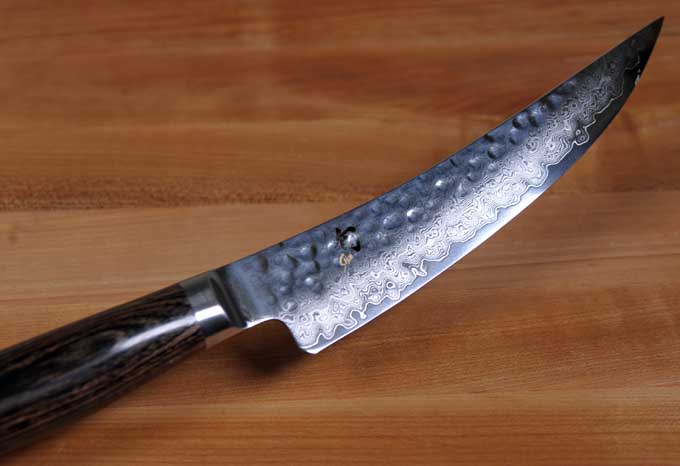
Shun Premier Gokujo, available on Amazon
They have enough room for knuckle clearance that they can even be used as a substitute for a chef’s knife in a pinch, but are nimble enough to peel an apple. The profile of the tip is such that they could even be used to skin out large game.
In short, I’m finding that they are some of the best multi-use knives in my collection and I absolutely love them.
Both semi-stiff and flexible blades will have a very sharp pointed tip that’s used to pierce the meat, and leads the cut when held with an overhead dagger-style grip for slicing along large bones.
Altogether, the length, slender blade shape, sharp tip, and pliability help the boning knife to maneuver for clean, precise cuts with optimal control, ensuring maximum yield.
Of course, they can be used for other slicing duties as well, such as creating steaks, cutlets, rib racks, and crowns. And thanks to their slim, sharp cutting edge and deft maneuverability, many folks like to use them for peeling and paring soft-skinned fruits and vegetables as well.
Not a Cleaver
To be clear, a boning knife is not designed for cutting through large bones – they’re far too light and delicate for this work. For chopping bones, you want a big, brawny meat cleaver.
But most models can handle cutting through cartilage or the small bones found in fish and poultry, and will also work for lightly scraping along larger bones.
Now let’s move on to some reviews and recommendations.
The 12 Top Rated Boning Knives and Gokujos Reviewed
Wusthof Classic Flexible Boning Knife: Best for Most People
From the Classic line of German cutlery maker Wusthof, we have their flexible boning knife with a 6-inch blade.

The long, narrow blade has only a slight curve from heel to belly to glide cleanly along the bone, which makes it ideal for deboning chicken, pork, or beef. Because of its flexible nature, it’s very easy to maneuver around small bones and can be used to fillet some fish as well.
The full bolster drops down to form a finger guard to prevent fingers from slipping along the cutting edge when handling greasy skin and fat.
The Classic features a full tang, and is forged from a single blank of high-carbon stainless steel, which is tempered to 58 HRC. This allows the blade to be keenly sharpened, and has the toughness to handle boning tasks without chipping.

Wusthof Classic 6-Inch Flexible Boning Knife
The edge is ground with Wusthof’s Precision Edge Technology (PET), then hand honed to create a superior sharpness that will retain its cutting edge for twice as long as a traditional grind.
The full tang is attached with three stainless steel rivets for outstanding strength and is permanently bonded to the highly durable synthetic Polyoxymethylene (POM) handle – which resists fading and discoloration, and is stickered with Wusthof’s red trident logo.
Wusthof makes another version in their Classic line, with all the same components of German steel, style lines, POM handle, and dimensions, but it comes with a granton edge.
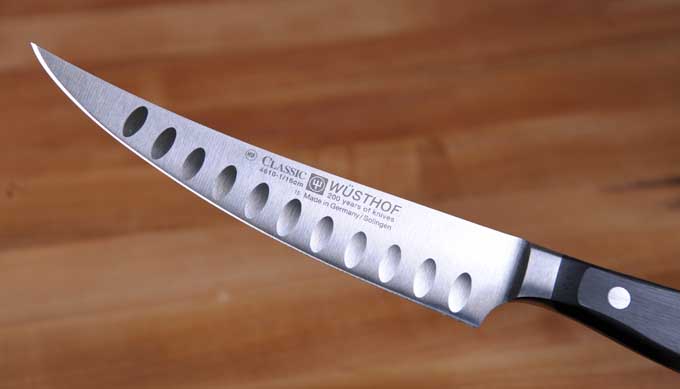
The hollow edge is crafted with evenly spaced vertical divots that create small air pockets between the blade and the food. These pockets reduce friction and resistance, and gently push food off the blade for a cleaner release.
Wusthof Classic 6-Inch Curved Boning Knife with Granton Edge
Both models are dishwasher safe, although hand washing and prompt drying are recommended.
With a 6-inch blade, both models have an overall length of 11 inches. The classic model weighs 6.7 ounces and the granton edge model is slightly lighter at 6.4 ounces.
Both are made in Germany, and come with Wusthof’s limited lifetime guarantee to be free of material and manufacturing defects.
Our Findings
The Wusthof Classic gets top marks for its comfortable hand feel and balance, its sharp, long-lasting edge, and excellent maneuverability.
This knife is super comfortable to use, with the attributes of heft, hand feel, and balance all making it a blade that can be used with confidence and control.
The flexibility of the blade makes boning, trimming, and skinning easy tasks. Light and nimble, it moves deftly around large and small bones, and works perfectly at skinning jobs.
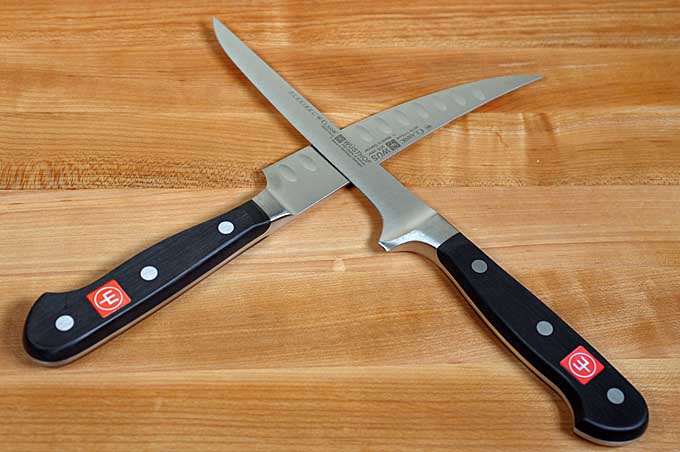
Both models are equally effective at filleting fish – the thin, light blade does a good job of cutting and cleaning without any damage to delicate fish flesh.
And the German steel cutting edge is a highlight as well. Sharp right out of the box, the Wusthof is great at holding a keen edge and requires only the occasional touchup with a honing steel – even when processing large amounts of meat, like venison.
The blade shape is another feature that adds to its efficient nature. The sharp tip moves around large bones as easily as it separates skin from a salmon, and the cutting edge has the strength to process joints and large bones quickly and cleanly, with virtually no waste.
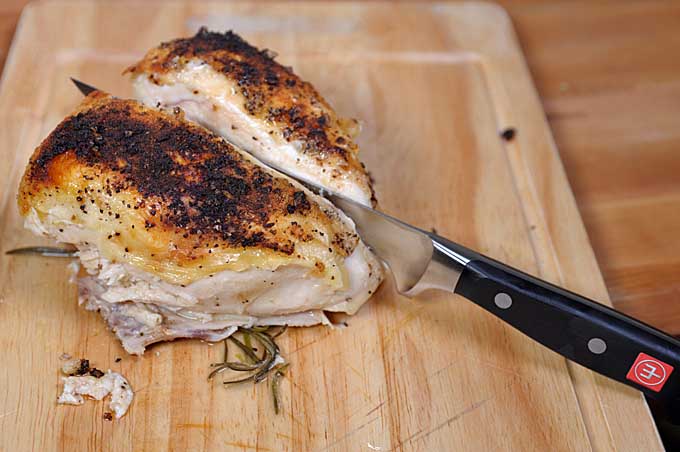
Plus, the blade length makes it easy to handle – a nice feature for those who don’t have a lot of experience with boning.
Summary
The Wusthof Classic flexible boning knife is a popular choice with online shoppers on Amazon as it has all the attributes you want to make boning efficient and easy.
The sharp blade on both models has excellent edge retention, making either ideal for processing large amounts of meat without having to stop and hone, and it has enough flex to make it viable for filleting fish.
Both cut cleanly to the bone of poultry, game, domestic meat, and large fish with a minimum of waste. And you can trim fat, portion steaks, or rack a lamb with either of these top performers – they perform any task effectively.
Check prices on Amazon now for the straight blade model or the granton edge model.
Victorinox Fibrox Pro: Best Budget Models
Victorinox brings us a great budget model in their Fibrox Pro boning knife with a thin, flexible blade.
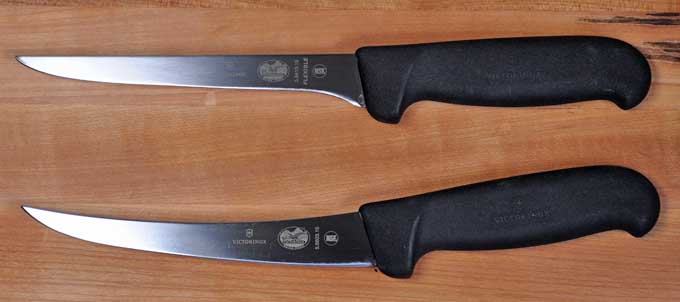
The stamped blade is constructed of high-carbon stainless steel for superb rust and corrosion resistance, and is ice-tempered to 58 HRC for durability and toughness.
The sharp cutting edge has a conical grind for a wide break point – which makes deft, agile cuts close to the bone with minimal waste.
Its flexibility makes it ideal for separating meat, poultry, and fish from the bone, and for skinning and trimming duties as well.

Victorinox Swiss Army 6-Inch Fibrox Pro Boning Knife with Flexible Blade
With a keen pointed tip for piercing, this model has no bolster, so the entire length of the blade can be used for cutting. And the finger guard is built in to the handle.
The Fibrox handle is ergonomically designed for balance, comfort, and safety with a pebble texture for a slip-free grip, along with the contoured finger guard.
NSF approved, the Fibrox Pro Flex is dishwasher safe, although handwashing is recommended.
It has a 6-inch blade with an overall length of 11.5 inches, and weighs 3.8 ounces.
Made in Switzerland, it comes with the Victorinox lifetime warranty to be made of first class stainless steel and free of any defects in material and workmanship.
Victorinox also produces a curved semi-stiff blade in the Fibrox line. And like the Pro Flex, the blade length, construction materials, handle, and warranty are all the same.
Victorinox 6-Inch Curved Fibrox Pro Boning Knife with Semi-Stiff Blade
The main difference is that the blade has an arched profile instead of a traditional one and is slightly thicker, weighing 4.5 ounces.
This extra bit of heft makes it steadier for cutting thicker meats, and with the semi-stiff blade, there won’t be quite as much pliability or side-to-side motion – which gives a greater sense of control.
Victorinox also offers a curved and flexible blade version that we did not examine in person.
Our Findings
The Victorinox Pro gets top grades for its flexible blade, the textured non-slip handle, and its sharp cutting edge.
For the price, the quality of the blade is exceedingly high. It has enough flex to handle boning smaller items like fish and chicken, but doesn’t have the flimsy feel of many stamped blades. It’s well-suited to handle boning any cuts of meat, including large pieces such as game and whole hogs.
The Fibrox handle is another highlight. Skinning chicken and fish can be slippery business, but the shape, texture, and built-in finger guard give a secure, confident grip. And for those that process large amounts of meat, fatigue-free comfort over a long period is another highlight due to its ergonomic design and light weight.
The sharp tip and cutting edge, as well as the blade shape, make the knife quite nimble and precise for following odd-shaped bones and joints with a minimum of waste.
The Victorinox arrives fairly sharp, and it has good edge retention as well. Even when processing large amounts of protein, you will be able to power through the entire job with no need to stop for honing.
Keep in mind, however, that if you are using it for tough jobs like boning out deer, a touch up or two on the steel wouldn’t hurt.
Summary
The Victorinox Fibrox Pro Flex boning knife is another highly popular model with online shoppers.
It delivers the precision and efficiency of a flexible blade for resistance-free cutting, but also has the strength to handle thicker cuts with equal ease. Lightweight and comfortable, the Fibrox handle makes any cutting tasks easy and efficient.
Designed to make boning and skinning swift and simple, the Fibrox Pro is a great combination of quality and value.
Check prices and read customer reviews on Amazon now.
Shun Classic Gokujo: A Higher End Japanese Option
From Shun’s Classic line, this Japanese gokujo is designed for both boning and filleting.
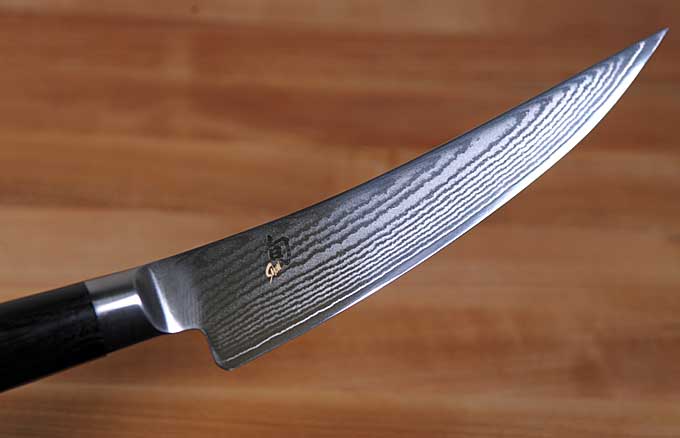
The arched shape and sharp cutting edge of this rigid blade makes it ideal to get in close to easily separate meat from bone, tendons, and joints. And its narrow profile will quickly slice through larger fish as well.
The forged blade is crafted with Shun’s proprietary VG-MAX steel with an HRC of 61 for an incredibly sharp cutting edge and long-lasting edge retention. The core is then clad with 34 layers of Damascus stainless steel on each side, which is ground and bead-blasted to reveal the flowing pattern of layered steel.
Beautiful to behold and corrosion resistant, the cladding also helps to prevent foods from sticking.
Ground in a double bevel to 16°, the hand-sharpened edge reduces drag for fatigue-free use, and excels at slicing tasks such as trimming away fat and silver skin.
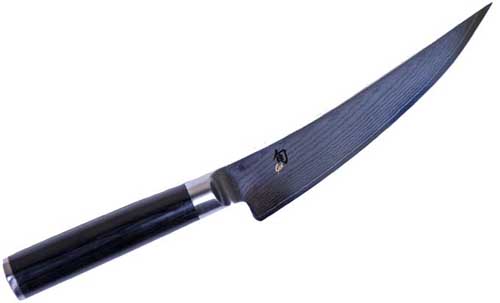
Shun DM0743 Classic Gokujo Boning and Fillet
The D-shaped handle is made of pakkawood and finished with a stainless steel end cap, and provides a secure grip for excellent control. Created for right-handed users, many lefties find the handle shape to be equally comfortable to use with confidence.
Hand washing and prompt drying with a soft cloth are recommended.
The blade measures 6 inches with an overall length of 11 inches, and weight of 7.2 ounces. Made in Japan, it comes with Shun’s limited lifetime warranty against material and manufacturing defects.
Our Findings
Shun’s gokujo gets top marks for its outstanding sharpness, superb slicing action, and comfortable handling.
With an excellent slicing motion for trimming meat and removing skin, the shape of the sharp blade allows it to glide through fat and fibrous tissue. It removes poultry, fish, and silver skin with ease.
The thin point and curved design enable it to separate meat from the bone cleanly, making it a good choice for butterflying and cubing meat as well.
The forged blade doesn’t have a lot of flex. And while it may be used successfully to bone and fillet large fish, its rigidity makes it more suitable for breaking down thick cuts, as there’s little sideway motion.
The handle is comfortable for both right and left-handed users, and it provides a sure grip for user confidence. Exquisitely balanced, the hand feel and control are top notch.
Summary
Typical of all Shun knives, the Classic boning and filleting gokujo is made of high-quality steel that features a razor sharp edge, outstanding edge retention, and elegant aesthetics.
However, care needs to be taken when working with hard bone to ensure the ultra-fine, high-carbon edge and tip don’t get damaged. And due to its stiff nature, filleting delicate fish and boning smaller pieces will be a challenge for many.
Wonderfully efficient at slicing tasks, the Classic gokujo is best suited for trimming meats and creating select cuts like tenderloin, ribeye and porterhouse steaks, and rib racks and crowns; butterflying leg meat; and cubing meats for stir-fries.
Check prices and read customer reviews on Amazon now.
Enso HD Hammered Damascus: Nimble and Maneuverable
Enso HD knives, like this hammered Damascus clad boning model, are crafted in Japan by the famous Yaxell Corporation, then rebranded as Enso for the North American retail market.

Typical of Japanese blades, the VG-10 steel cutting core has an HRC of 61 and has been hand ground in a double bevel for a razor-sharp cutting edge that also provides superb edge retention.
Over the top of the core, the blade is clad with 37 layers per side of Damascus stainless steel for outstanding stain, rust, and corrosion resistance. Hand hammering creates the distinctive tsuchime finish – striking in appearance, hammering also has a functional practicality as it creates small air pockets to prevent foods from sticking, and allows morsels to be gently pushed from the blade.
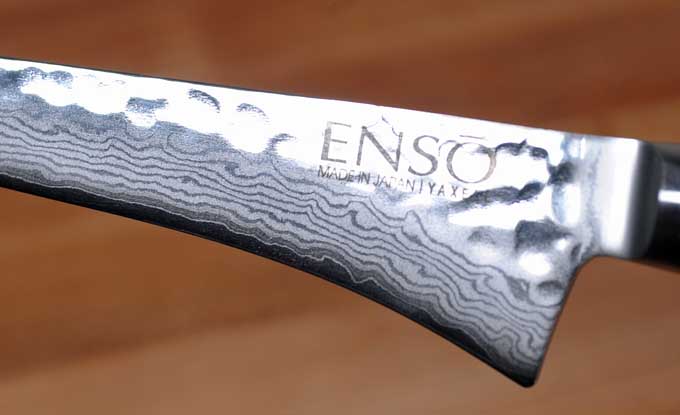
Handles are made of FDA-approved black linen micarta, a composite of thermoplastic resins and layers of linen for a similar look and feel as wood. Tough and durable, micarta will provide years of use without cracking.
The handle is secured in place with three stainless steel compression rivets, and a full tang runs the length of the handle, which is finished with a stainless steel cap.
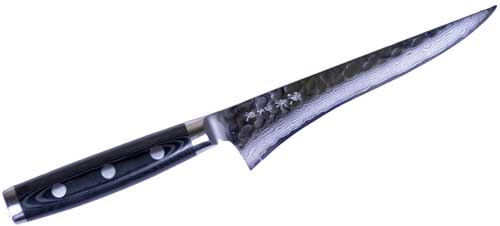
Enso HD Hammered Damascus 6-inch Boning Knife
A full bolster adds balance and control, and drops down to form a finger guard along the heel of the blade for extra safety and stability.
The Enso HD has a 6-inch blade, with an overall length of 11 inches, and weighs 6.4 ounces. Hand washing and prompt drying with a soft cloth is recommended.
It comes with Enso’s lifetime warranty to be free of material and manufacturing defects. Made in Japan.
Our Findings
This knife from Enso is ranked highly for excellent craftsmanship, high quality components and construction techniques, outstanding sharpness, and exquisite finishing details – with very few complaints.
Summary
The Enso HD Damascus boning knife with hammered finish has all the qualities that you are looking for in an artisanal Japanese knife.
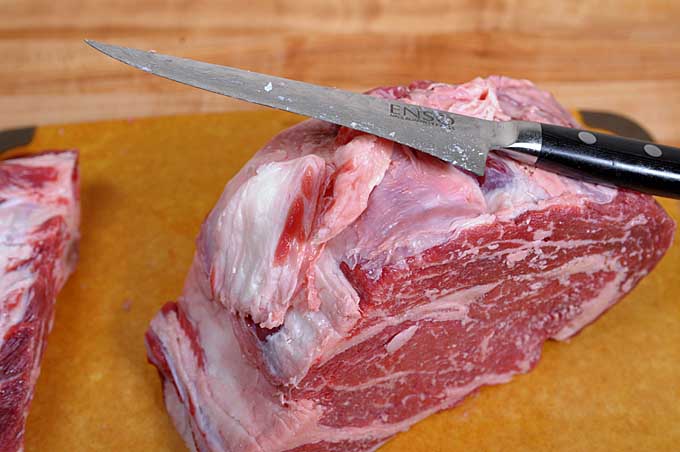
The strong, sharp tip will easily pierce the flesh of poultry, fish, and beef, and the slender shape of the blade is designed to closely follow the contour of bones and tendons for the clean separation of layers.
The high-carbon steel core is known to be sharp and long lasting, with Enso components carefully fitted and finished for handsome aesthetics and functional practicality.
Check prices and read more reviews on Amazon now.
Shun Premier Gokujo: Editor’s Choice
Another gokujo from Shun, this one is from their Premier line.
The narrow, sharp, and curved blade of the rigid Premier gokujo boning and fillet knife is designed to get in close to the bone and cleanly separate meat with very little waste.

With an extremely sharp edge, cutting through fibrous tissue is quick and easy, making it the perfect tool for trimming fat and silver skin, dressing fancy cuts, or for fine slicing.
The blade core is made of Shun’s proprietary VG-Max, a high carbon alloy with an HRC of 61. It has a flat-ground 16° double bevel to take and hold a scalpel-sharp cutting edge, and to release food quickly from the blade.
The core is clad with a total of 64 layers of flowing Damascus stainless steel for outstanding stain, rust, and corrosion resistance. A hand-hammered tsuchime finish adds a unique aesthetic to the blade, and along with the Damascus cladding, reduces drag and helps to prevent food from sticking.
It’s fitted with a sleek and stylish walnut-finish pakkawood handle that has a contoured oval shape suitable for both right and left hands – it gives a comfortable, secure grip that supplies excellent control.
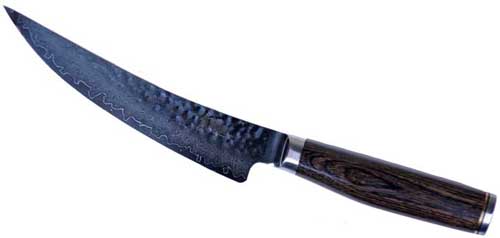
Shun TDM0774 Premier Gokujo Boning Fillet Knife
With a full bolster that lends stability and balance, the blade heel is slightly offset from the handle with a finger guard to provide extra safety from the sharp cutting edge.
The Shun logo is embossed on the stainless steel end cap for an impressive display both in and out of the knife block.
Hand washing only is recommended, with prompt drying from a soft cloth.
The Premier gokujo has a 6-inch blade with an overall length of 11 inches, and weighs 4.5 ounces.
Made in Japan, it comes with Shun’s limited lifetime warranty to be free of material and manufacturing defects.
Our Findings
The Shun Premier gokujo receives top marks for its extreme sharpness, top-quality construction, and superb slicing.
The Premier arrives out the box exceedingly sharp.
It does an outstanding job of cutting through fat and tough tissue, and slicing delicate meat like fish without causing any damage. And the blade shape is perfectly angled for removing skin from poultry or fish without any knife movement.
Crafted with artisanal care, all components are professionally fitted, and finishing details are superb.
Light and deft, the Premier has a fine balance that makes it easy to handle and control. And the handle is comfortable for use in either hand.
If you have a magnetic knife bar, the distinctive and striking appearance when mounted next to lesser knives is a beautiful thing to behold indeed.
Summary
With a bold, eye-catching design, the Shun Premier gokujo boning and fillet knife is equally proficient as a boning and trimming blade.
With an extremely sharp edge and hammered Damascus finish, it debones meat cleanly and efficiently, and excels at trimming and dressing duties.
Distinctly stylized, it’s every bit as hard working as it is flashy.
Check prices and read more reviews on Amazon now.
Dalstrong Phantom: Best Bang for the Buck
Dalstrong is a newer company that has chosen to use the best metals available in both the Western and Eastern traditions while holding prices down at a reasonable level – and at a much higher degree of fit and finish than you’d normally find at this price point.
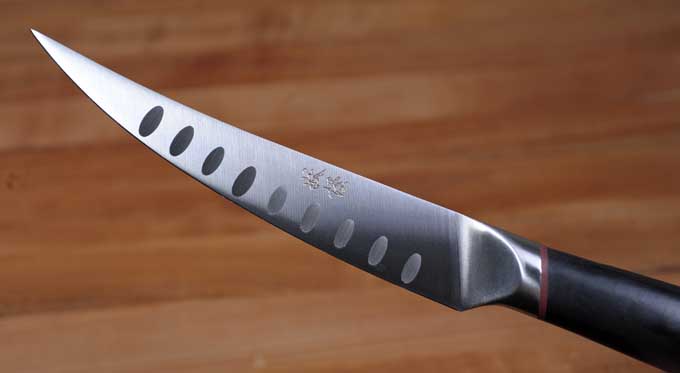
How did Dalstrong accomplish this extraordinary feat? They import German and Japanese steel alloys to their shop in China where skilled craftsmen create their blades, keeping production costs low while still maintaining very high quality.
It’s not always a given that Chinese manufacturers produce inferior goods, and this is definitely NOT the case with Dalstrong. (Companies that outsource to China are typically looking to cut costs in many ways – labor costs being among these. And they also often cheapen components, fit and finish, etc. But this does NOT have to be the case).
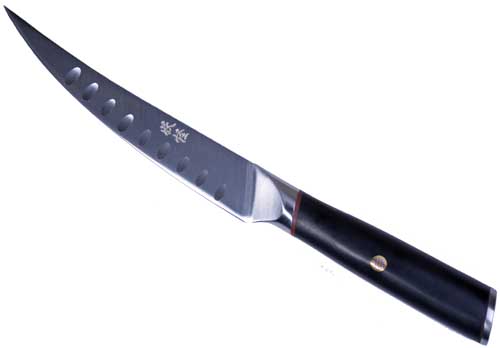
DALSTRONG Phantom Series Boning and Filet Knife
This particular blade from the Dalstrong Phantom series is composed of Japanese AUS8 steel that has been expertly tempered and nitrogen cooled, resulting in a Rockwell hardness of 58 or higher – meaning that the very sharp factory edge will last a long, long time (but making it a bit of booger to resharpen when the time comes).
Unlike many other Japanese-style knives with traditional D or Wa (round or octagonal) handles, this blade features a full tang, which incorporates one solid piece of steel running from the tip to the end of the handle.
And speaking of handles:
The D-shaped handle found on this beauty is composed of a hand-polished Spanish pakkawood designed to fit perfectly into the palm of your hand, ensuring control, maneuverability, and ergonomic hand placement.
This Dalstrong Phantom Series boning knife includes a nifty plastic scabbard that protects the blade and allows for easy transportation – making it ideally suited to the professional chef who needs to carry his or her tools in to work every day.
This hardened plastic sheath also makes it great for packing into a hunting kit. This blade is ideal for skinning out and deboning deer, elk, and other large game, and the Japanese steel alloy in the blade allows you to process carcass after carcass without the need to stop and sharpen.
Our Findings
The Dalstrong Phantom Series boning knife comes extremely sharp from the factory and is one of our favorite selections.
The blade has been angled and tapered for reduced drag, and the scalloped indentations ensure limited sticking from both protein and veggies, should the need arise to use it as a utility knife.
This was by far the best packaged boning knife that we tested. You can tell that Dalstrong is very proud of their product just by the container in which it arrives. It was more akin to unpackaging an iPad or iPhone rather than a kitchen tool.
Besides the plastic scabbard, the knife comes packaged with a cleaning cloth, care instructions, a little medallion, and a card promising customer satisfaction and happiness.
There is no real choil or bolster (like all traditional Japanese-style knives have) so there is a bit more of a risk of slipping and cutting yourself, but this small point should not dissuade you from purchasing this fine tool.
Summary
The Dalstrong is a high-end product available at a reasonable price, a definite contender for any home or professional cook, or even the avid outdoorsman.
High-end alloys, great fit and finish, and a reasonable price all contribute to make this one the perfect bang-for-the-buck pick.
Check prices and read more reviews on Amazon now.
Mercer Genesis
Mercer cutlery is well known at the cooking academies of North America. And this is where many professional cooks and chefs get hooked on their knives, thanks to Mercer’s winning combination of quality and value.

This 6-inch flexible boning knife is from their professional Genesis line, and is constructed from a drop-forged, high-carbon German steel with an HRC rating of 58 – which provides strength and durability, as well as excellent rust, stain, and corrosion resistance.
The taper-ground bevel produces a sharp, long lasting cutting edge that reduces resistance when slicing, and adds extra stability. Highly efficient for the task of boning, it retains a keen edge even when processing large amounts of meat.
A full tang runs the length of the handle for excellent balance and control, and the bolster drops down to form a finger guard for extra safety when handling thick or slippery cuts.
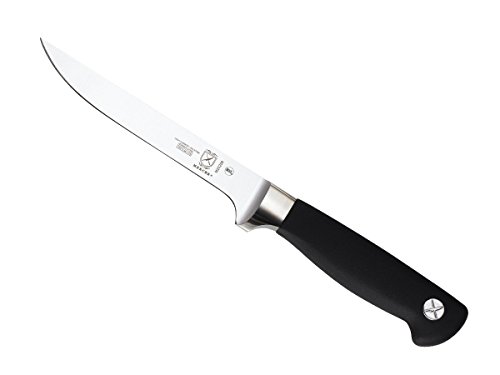
Mercer Culinary Genesis 6-Inch Forged Flexible Boning Knife
The NSF-certified handle is made from contoured non-slip Santoprene that gives a sure grip plus ergonomic comfort, and won’t break down from exposure to hot and cold temperatures, or kitchen oils.
The Genesis boning knife should be hand washed and promptly dried with a soft towel.
Mercer also produces a rigid boning knife in their Genesis line.
Mercer Cutlery M20106 6-Inch Genesis Forged Stiff Boning Knife
All components are identical to the flexible version, with the same German steel, dropped bolster, and Santoprene handle.
Both blades measure 6 inches, and have a total length of 11 inches and weight of 7 ounces. Made in Taiwan, they come with Mercer’s one-year warranty to be free of manufacturing and material defects.
Our Findings
The Genesis flexible boning knife receives top marks for the comfortable handle, its well-balanced feel, and the German steel that takes and holds a sharp edge.
The Mercer Genesis is well made with good balance and weight, which gives a sense of control and sure handling.
The German steel has excellent rust and corrosion resistance, can be sharpened to a fine cutting edge, and retains its sharpness for long periods with only the occasional honing required.
The textured Santoprene handle is another selling point, as it gives a firm, robust surface for a sure grasp, but also provides a comfortable hold for long sessions.
The degree of flexibility is another highlight, with the sharp tip and blade providing enough movement to easily follow bones and tendons without damaging delicate tissue.
Be sure to care for it properly and dry it promptly after cleaning to avoid rust.
Summary
The Mercer Genesis flexible boning knife proves to be a well built and reliable performer.
This is a knife that delivers high-level cutting performance, durability, and ease of use at a low cost.
With this model, you’ll find a good middle-of-the-road tool that blends value with user-friendly design for consistent results – without breaking the bank.
Check prices on Amazon now for the flexible blade model or the stiff blade model.
Henckels Classic Semiflex
Here’s another Western-style model, this time from the Classic line of J.A. Henckels.
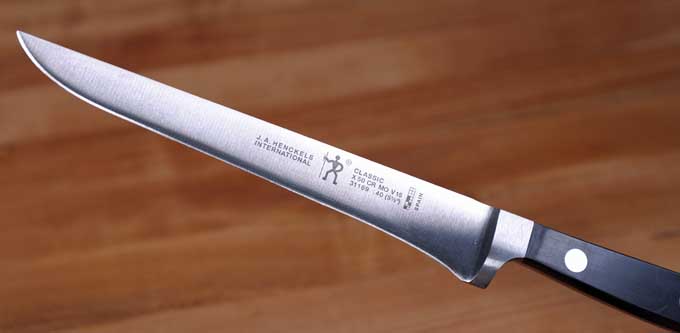
This slim, thin blade is the perfect shape for slicing away flavorful meat close to the bone, without causing any damage to the meat.
A smallish knife with a sharp, firm tip and strong, straight cutting edge, the Semiflex blade provides a bit of give for moving around big bones and joints. It also has the dexterity to separate poultry and fish, and can even be used for cleaning, peeling, and cutting small fruits and veggies.
Henckels’ Classic knives are forged of high-quality German stainless steel that offers superb rust, corrosion, and stain resistance, and has been tempered with ice hardening to 58 HRC for strength and durability.

J.A. Henckels International CLASSIC 5.5-Inch Boning Knife
The qualities of the steel give a long-lasting, keen edge that has been laser ground for superb symmetry.
This boning knife features a full bolster with dropped finger guard that adds weight, comfort, and safety.
A full-length exposed tang adds extra balance and control, and the traditional three-rivet polypropylene handle provides a secure, firm grip that’s comfortable, attractive, and durable.
The Classic boning knife is dishwasher safe, although handwashing is recommended.
With a blade length of 5.5 inches and an overall length of 10.5 inches, it weighs 6.4 ounces.
Made in Spain, it comes with the Henckels lifetime warranty to be free of manufacturing and material defects.
Our Findings
The Henckels Classic receives top marks for its sound European construction, its efficiency at processing large and thick cuts, and its versatility for use on different foods.
The Classic is well made with quality components and construction. It has a nice balance, and a comfortable hand feel that makes it easy to use and control.
The blade is thin with a bit of flex, but it still performs well at processing large game, separating chicken parts, and boning large fish,. It is also handy at peeling soft fruit and thin-slicing tomatoes.
It arrives sharp from the factory, and holds a good edge for a considerable amount of use.
Plus, the handle provides a sure, steady grip that doesn’t get slippery when cold or wet.
Summary
The Henckels Classic Semiflex boning knife is another well-crafted and steadfast performer that proves to have multiple uses.
The German steel is of high quality for a sharp cutting edge, and the thin, semiflexible blade is proficient at breaking down large pieces of meat and game, as well as poultry and large fish.
It also doubles nicely as a fruit and vegetable knife, with the short blade adept at peeling and thin-slicing duties. This is a versatile blade that offers good value with multiple applications.
Check prices and read more reviews on Amazon now.
Dexter-Russell Sani-Safe
Look in any tackle box in North America and chances are pretty good you’ll find a Dexter-Russell (DR) boning or fillet knife.
Thin and flexible, this boning knife has a gentle upward curve for slicing meat, poultry, or fish with a smooth action.
The curve and pliability combine to work around bones, tendons, and joints to cleanly separate, trim, and skin proteins, and the sharp tip is good for piercing tasks.
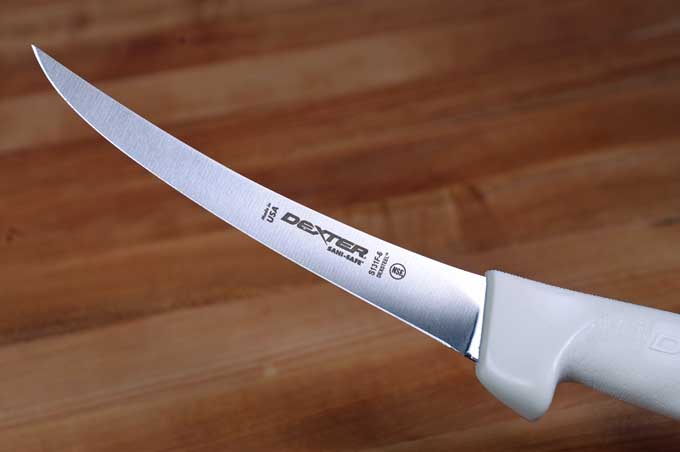
The blade is constructed of Dexsteel, Dexter-Russell’s proprietary, high-carbon, high-alloy stainless steel – it’s been specially engineered for their professional knives to enhance sharpness, edge holding, corrosion resistance, and for ease of re-sharpening.
Hand sharpened and honed, the blade has a hardness of 54 HRC for durability and strength.
The Sani-Safe line features an NSF-certified Grip-Tex handle – a textured, stain resistant polypropylene material that can withstand high and low temperatures, and is sealed to the blade with an impervious barrier for the best in hygienic surfaces.
Dexter-Russell (S131F-6PCP) – 6-Inch Boning Knife – Sani-Safe Series
Large and ergonomically designed for slip-resistant comfort, the handle design and built-in finger guard also provide extra safety and stability.
The DR Sani-Safe has a blade length of 6 inches, an overall length of 11 inches, and it weighs only 3.2 ounces. Dishwasher safe, hand washing is recommended.
It comes with Dexter-Russell’s lifetime guarantee to be free from defects in material and workmanship. Made in the USA.
Our Findings
The Dexter-Russell gets top marks for its trimming and slicing abilities, the comfortable, non-slip handle, and its well-balanced feel.
The shape of the blade and sharp edge make it ideal for separating layers, and trimming and slicing duties like dressing a brisket or fine-slicing jerky for the smoker.
The large handle gets plenty of compliments as well. It proves to be comfortable to hold and use, and doesn’t slip even when hands get greasy. And the large finger guard is an appreciated feature for the prevention of accidental cuts.
The DR has a lightweight, well-balanced feel that gives good control and fatigue-free handling. It arrives sharp and holds an edge well, even with extended use.
The Dexter-Russell is the blade of choice among many butchers, meat packers, and reasturant owners who provide them as “house” knives. This is attributable to their low cost, ergonomics, ability to be “steeled” back into shape, dishwasher safe build, and NSF stamp,
Summary
The Dexter-Russel Sani-Safe flexible boning knife is a reliable model that’s well suited for trimming, slicing, and dressing duties.
Safe, hygienic, and strong, the DR is a good option for the kitchen or sportsman’s bag as well as professional use, and provides a nice blend of value and performance.
Check prices and read more customer reviews on Amazon.
Make No Bones About It…
For the best results in deboning and skinning meat, game, and poultry, or for dressing and trimming select cuts of meat, a good quality boning knife is absolutely essential to add to your set of kitchen blades.
Choose a blade shape with the suitable pliability for the type of work you plan to do most often, and you’ll love how easily these tasks fall into place. You’ll feel like a pro using the right tool for the job, and the savings you’ll enjoy from creating your own premium cuts is a definite bonus!
Now, how about you readers – any tips or insights you can share about using these beautiful knifes? Drop us a line in the comments below!
And make sure to check out all of our kitchen knife reviews and buying guides now.
Photos by Mike Quinn, © Foodal / Ask the Experts, LLC. ALL RIGHTS RESERVED. Additional writing and input by Mike Quinn. See our TOS for more details.
About Lorna Kring
Recently retired as a costume specialist in the TV and film industry, Lorna now enjoys blogging on contemporary lifestyle themes. A bit daft about the garden, she’s particularly obsessed with organic tomatoes and herbs, and delights in breaking bread with family and friends.


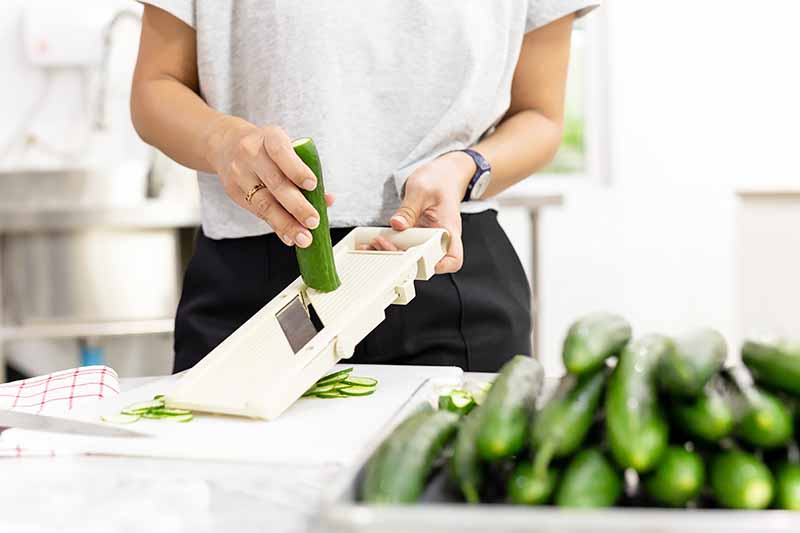

Mercer Genesis knives come with a limited lifetime warranty, not just one year.
Thanks for writing this article on boning knives; it’s a good read. For historical reference, my team developed the “Gokujo”, shape (meaning Superior or Best) back in 2005 or so, to get more utility out of a rigid steel boning knife, since our Kasumi clad blades did not allow for flex. (I was with Shun at the time). Despite the name, this blade geometry was designed in Oregon, and as such, has found its way into the lineup of many western cutlery brands. I think that the best performing iteration of this shape is when it has been used with a medium-firm flex homogenous steel. Give it a try, it’s still one of my favorite go-to kitchen tools for butchery.
Excellent article. I appreciate the thought and craft that went into developing your studied conclusions.
You lost me at the Dexter Russel, one of the worst knifes I have ever used, and the only knife that has ever snapped on me. Twice.
I have been a butcher for 25 years, so am very experienced in placing this comment.
Why did you not include the Zwilling Pro 5.5″ Flexible Boning Knife?
I would think the Henckels Pro would be more comparable to the Wusthof Classic than the Henckels International. No?
I received a used Dexter-Russell bread knife in 1988, and I have never once had to sharpen it. No joke.
There are many boning knife uses. Most include separating meat from bone, but not always. In some cases, it’s more of a trimming in the case of removing a fat cap or trimming fatty edges. Yet another way to use a boning knife would be to pare down larger cuts of meat into smaller pieces such as butchering a side of beef or quartering a chicken.
I don’t buy knife sets because I like different brands for different reasons. My favorite knife is the 8″ chef knife. I have a couple ranging from beater knives to very high end. I also have santoku knives, vegetable knives, cleavers, paring knives, bread knife, shears etc. I have some ceramic knives as well. They hold an edge for a long while.
The majority of these knives are fine for occasional deboning, but you will never find a forged knife in my shop. I can appreciate the difference between deboning meat in a kitchen setting vs. that in a dedicated meat shop, but I think there is at least one knife you should give a try!
Victorinox Fibrox seem to be the commonly preferred knife in most shops, though I personally do not like using them for extended periods. The handles are made of hard plastic and become uncomfortable with time. Might I suggest you look into Giesser knives? I have used many brands over the years, and these hold a superior edge. F. Dick is a great brand as well, but I have never managed to keep the level of sharpness with Dick knives that I have with Giesser.
Definitely go with the 6″ Curved Flex! Pair it with an F. Dick Dickoron Combi square steel, and you’ll be abandoning your Gillette razor for your boning knife before you know it! 😉
Give it a try and you will never look back! 🙂
How can you leave out the complete line of true French Sabatier knives, far superior to some of the ones you mentioned.